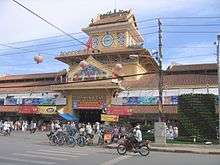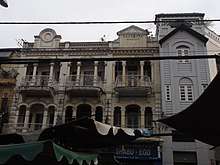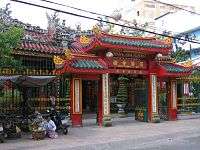Chợ Lớn, Ho Chi Minh City
Chợ Lớn (![]()
| Chợ Lớn, Ho Chi Minh City | |||||||||||||||
|---|---|---|---|---|---|---|---|---|---|---|---|---|---|---|---|
 Binh Tay Market in Chợ Lớn | |||||||||||||||
| Chinese name | |||||||||||||||
| Chinese | 堤岸[1][2] | ||||||||||||||
| Literal meaning | embankment | ||||||||||||||
| |||||||||||||||
| Vietnamese name | |||||||||||||||
| Vietnamese alphabet | Chợ Lớn | ||||||||||||||
| Hán-Nôm | 𢄂𡘯[3] | ||||||||||||||
The Vietnamese name Chợ Lớn literally means "big" (lớn) "market" (chợ). The Chinese name (and original name) is 堤岸 (pronounced Tai-Ngon in Cantonese and Dī'àn in Mandarin,[1][2] which means "embankment" (French: quais). The Vietnamese reading of the Chinese name is Đê Ngạn, but this is rarely used. Vietnamese speakers exclusively use the name Chợ Lớn, while Chinese speakers (both inside Vietnam and in China) are the only users of the original Chinese name.
History

The city of Chợ Lớn was established by the Hoa community. The Lê dynasty which was the ruling family in the sixteenth century began to decline in power and two rival families, the Trinh and Nguyen families began to vie for power to fill in the void of the Lê. Nguyen was then appointed as Viceroy of the South with headquarters at Huế where they encouraged Chinese immigration to settle down into the area.[4]
In 1778, Hòa living in Biên Hòa had to take refuge in what is now Chợ Lớn because they were retaliated against by the Tây Sơn forces for their support of the Nguyễn lords. In 1782, more than 10,000 Hòa were again massacred by the Tây Sơn and had to rebuild.[5] They built high embankments against the flows of the river, and called their new settlement Tai-Ngon (meaning "embankment" in Cantonese).
Chợ Lớn was incorporated as a city in 1879, 11 km from Saigon. By the 1930s, it had expanded to the city limit of Saigon. On 27 April 1931, Chợ Lớn and the neighbouring city Saïgon were merged to form a single city called ‘Saigon–Cholon’. The official name, however, never entered everyday vernacular and the city continued to be referred to as ‘Saigon’. ‘Chợ Lớn’ was dropped from the city's official name in 1956, after Vietnam gained independence from France in 1955.[6]
During the Vietnam War, soldiers and deserters from the United States Army maintained a thriving black market at Chợ Lớn, trading in various American and especially U.S Army-issue items. This was the area, near the Quan Âm Pagoda where photojournalist Eddie Adams took his famous execution photograph.[7] Four Australian journalists were also killed in Chợ Lớn during the Tet Offensive in 1968.[8]
Today, Chợ Lớn attracts many tourists, especially mainland Chinese and Taiwanese.
Notable residents
- Yvon Petra - He was born in Chợ Lớn. He is best remembered as the last Frenchman to win the Wimbledon championships men's singles title in 1946.
- Cao Văn Viên - Chief of the Joint General Staff of the Army of the Republic of Vietnam from 1966 to 1975.[9][10]
- Gontran de Poncins - French author, aristocrat and adventurer lived here in 1955. He resided in the Sun Wah hotel, keeping an illustrated journal which was published as From a Chinese City (published in 1957). "He chose Cholon, the Chinese riverbank community snuggled up to Saigon, because he suspected the ancient customs of a national culture endure longer in remote colonies than in the motherland. In effect, he was studying a bit of ancient China."[11]
- Charles Tran Van Lam
- Wan Kwong (Chinese: 尹光), born Lui Minkwong (呂明光 and also known as Jackson Wan Kwong), Hong Kong singer
Temples and Monuments

| Wikimedia Commons has media related to Chinatown, Ho Chi Minh City. |
- Quan Âm Pagoda, Ho Chi Minh City (觀音寺)
- Thiên Hậu Temple, Ho Chi Minh City
- Cho Lon Mosque
- Nhị Phủ Temple (二府廟)
- Hà Chương (Hokkien) Guildhall
- Miếu Quan Đế (關帝廟)
- Minh Hương Guildhall (明鄉嘉盛會館)
- Tam Sơn Guildhall (三山會館)
External links
- . Encyclopædia Britannica. 6 (11th ed.). 1911. p. 267.
literatier Ulrich Brinkhoff: Albträume am Saigon-Fluss. Agenda 2014, ISBN 978-3-89688-516-6. book contains many situations and fotos in Cholon. Sorry, German language only
References
- "Archived copy". Archived from the original on 2013-10-04. Retrieved 2015-11-15.CS1 maint: archived copy as title (link)
- Archived 2012-04-25 at the Wayback Machine
- Socio-Economic Background of the Hoa People (PDF) (Thesis). Shodhganga. p. 34.
- Socio-Economic Background of the Hoa People (PDF) (Thesis). Shodhganga. p. 34.
- P. 61, Historic Dictionary of Ho Chi Minh City (written by Justin Corfield; published by Anthem Press in 2013)
- Faber, John (1978). Great News Photos and the Stories Behind Them. Courier Dover Publications. p. 136.
- Colebatch, Hal G.P (30 October 2009). "The Saigon media slaughter". The Australian. Retrieved 2013-11-06.
- St. George, Donna. "Cao Van Vien, 1921-2008." Washington Post. January 2, 2009.
- Kinnard, Douglas. The War Managers: American Generals Reflect on Vietnam. Reprint ed. Cambridge, Massachusetts: Da Capo Press, 1991. ISBN 0-306-80449-2
- Book product description.